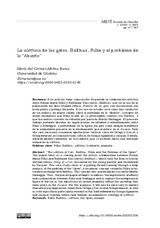Mostrar el registro sencillo del ítem
La alétheia de los gatos. Balthus, Rilke y el problema de lo “Abierto”
| dc.contributor.author | Molina Barea, María del Carmen | |
| dc.date.accessioned | 2023-01-10T12:47:36Z | |
| dc.date.available | 2023-01-10T12:47:36Z | |
| dc.date.issued | 2022 | |
| dc.identifier.uri | http://hdl.handle.net/10396/24485 | |
| dc.description.abstract | Este artículo toma como punto de partida la colaboración artística entre Rainer Maria Rilke y Balthazar Klossowski –Balthus– que vio la luz en la publicación del libro titulado Mitsou. Historia de un gato, con ilustraciones del joven pintor y prólogo del poeta. Este caso de estudio sirve como hilo conductor de un análisis de mayor calado sobre el problema de lo “Abierto”, concepto de orden nouménico que Rilke acuña en su intercambio creativo con Balthus, y que fue motivo concreto de reflexión por parte de Martin Heidegger. El presente trabajo pretende abordar las implicaciones de afinidad y enfrentamiento entre Rilke y Heidegger, y profundizar en la figura del gato como imagen metafórica de la animalidad presente en el develamiento que acontece en el Da-sein. Para ello será necesario considerar aportaciones teóricas clave de Ortega y Gasset y Schopenhauer, así como posturas críticas de Giorgio Agamben y Jacques Derrida, específicamente relevantes en este debate, que se inclinan hacia una ontología animal de la alétheia. | es_ES |
| dc.description.abstract | “The alētheia of Cats. Balthus, Rilke and the Problem of the ‘Open’”. This paper takes as a starting point the artistic collaboration between Rainer Maria Rilke and Balthazar Klossowski –Balthus–, which took the form of a book entitled Mitsou. Story of a Cat, illustrated by the young painter and foreworded by the poet. This case study serves as a guiding thread running through a deep analysis of the problem of the “Open”, a noumenic concept coined by Rilke in his creative exchange with Balthus. This concept was specifically discussed by Martin Heidegger. Thus, the present paper attempts to address the implications of affinity and confrontation between Rilke and Heidegger and to explore the metaphorical figure of the cat as the expression of certain animality within the unveiling that takes place in the Da-sein. For this purpose, it will also be necessary to explore theoretical key approaches taken from Ortega y Gasset and Schopenhauer, as well as critical positions particularly relevant in this field defended by Giorgio Agamben and Jacques Derrida, which tend towards an animalistic ontology of alētheia. | es_ES |
| dc.format.mimetype | application/pdf | es_ES |
| dc.language.iso | spa | es_ES |
| dc.publisher | Pontificia Universidad Católica del Perú | es_ES |
| dc.rights | https://creativecommons.org/licenses/by/4.0/ | es_ES |
| dc.source | Areté 34(2), 417-454 (2022) | es_ES |
| dc.subject | Rilke, Rainer Maria, 1875-1926 | es_ES |
| dc.subject | Balthus, 1908-2001 | es_ES |
| dc.subject | Alétheia | es_ES |
| dc.subject | Lo Abierto | es_ES |
| dc.subject | Animales | es_ES |
| dc.subject | The Open | es_ES |
| dc.subject | Animals | es_ES |
| dc.title | La alétheia de los gatos. Balthus, Rilke y el problema de lo “Abierto” | es_ES |
| dc.type | info:eu-repo/semantics/article | es_ES |
| dc.relation.publisherversion | https://revistas.pucp.edu.pe/index.php/arete/article/view/26324 | es_ES |
| dc.rights.accessRights | info:eu-repo/semantics/openAccess | es_ES |

